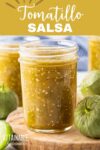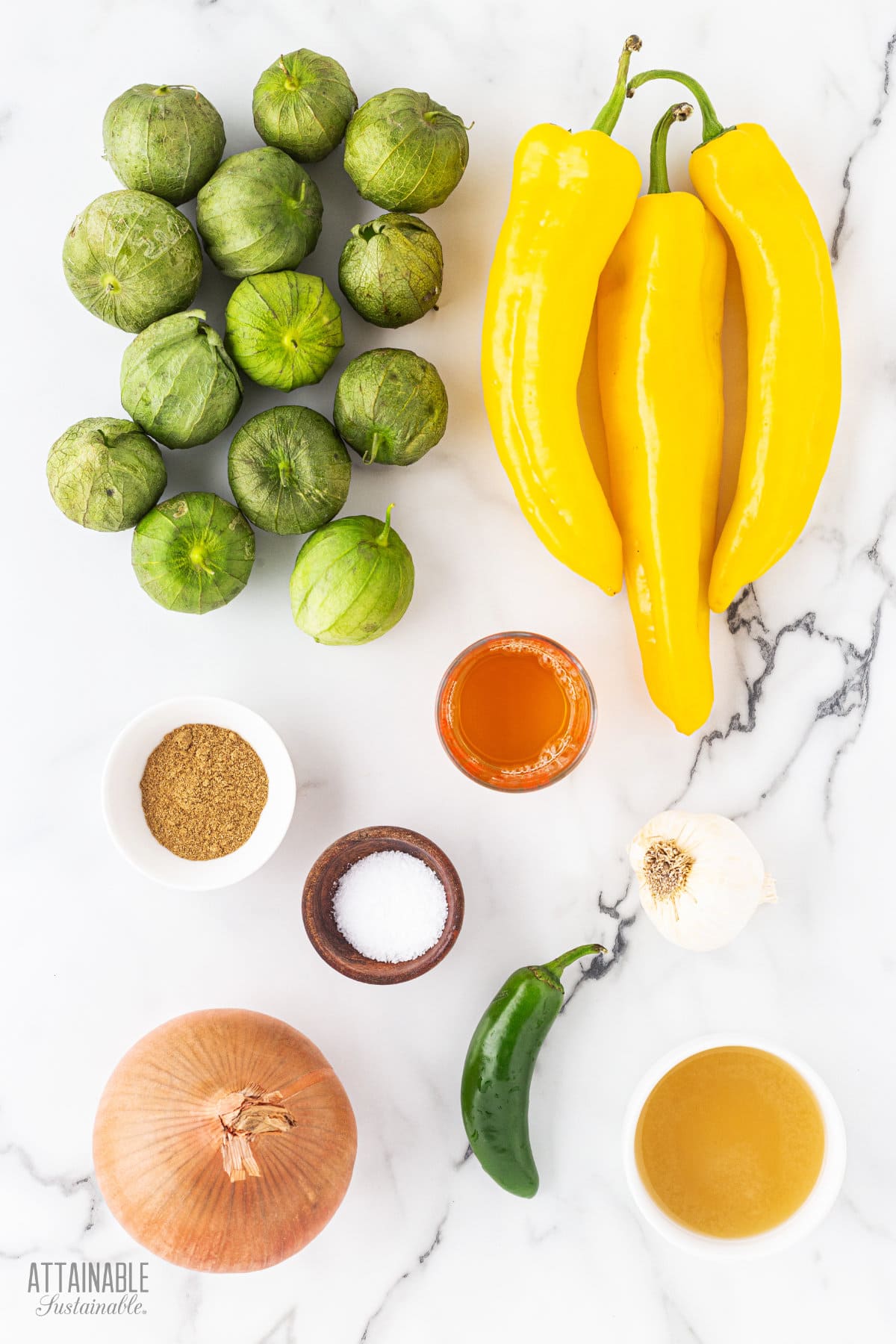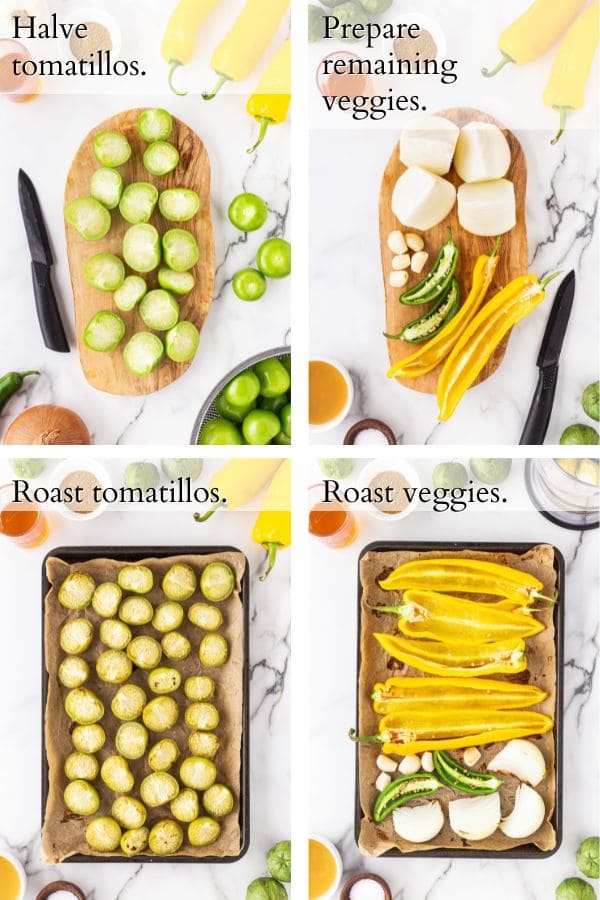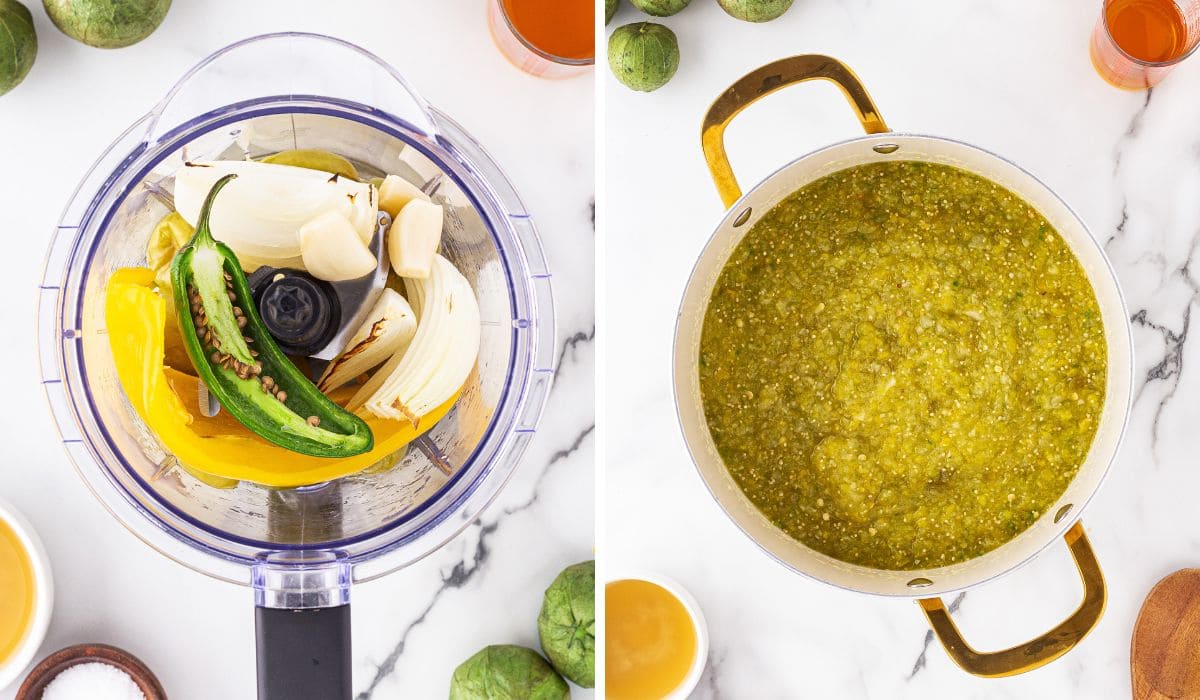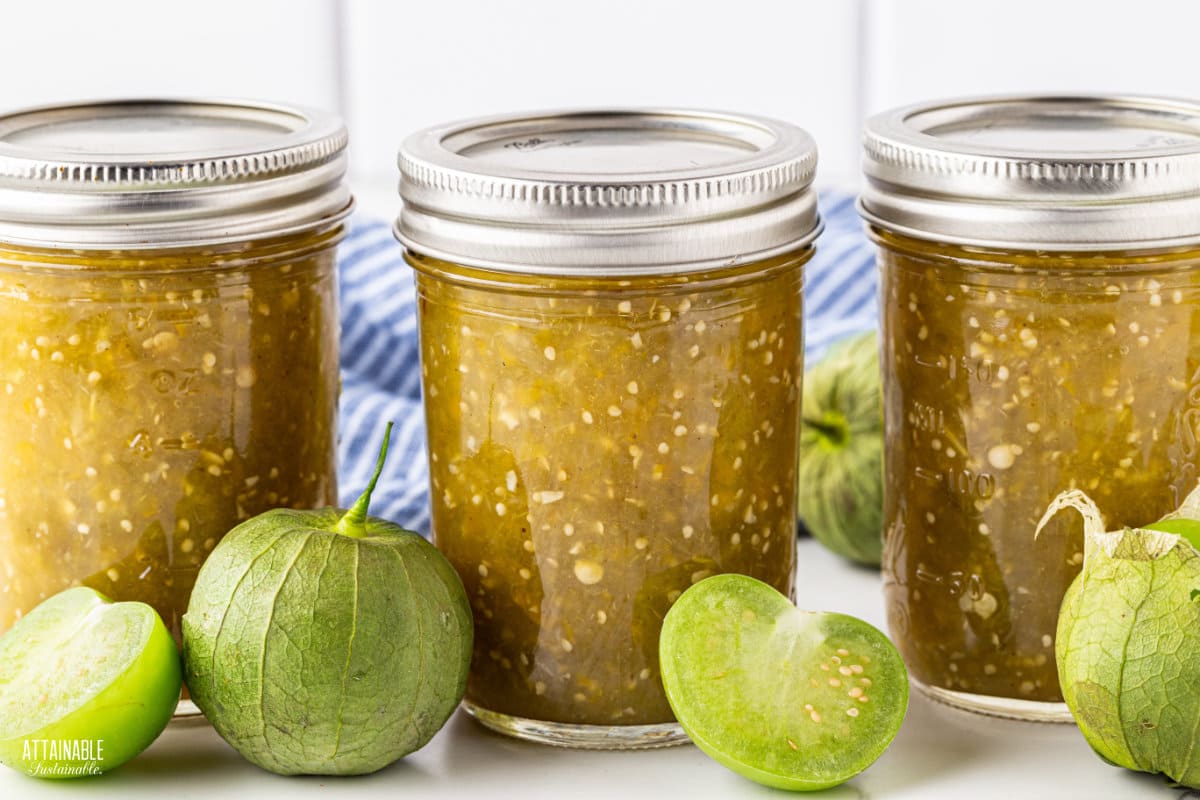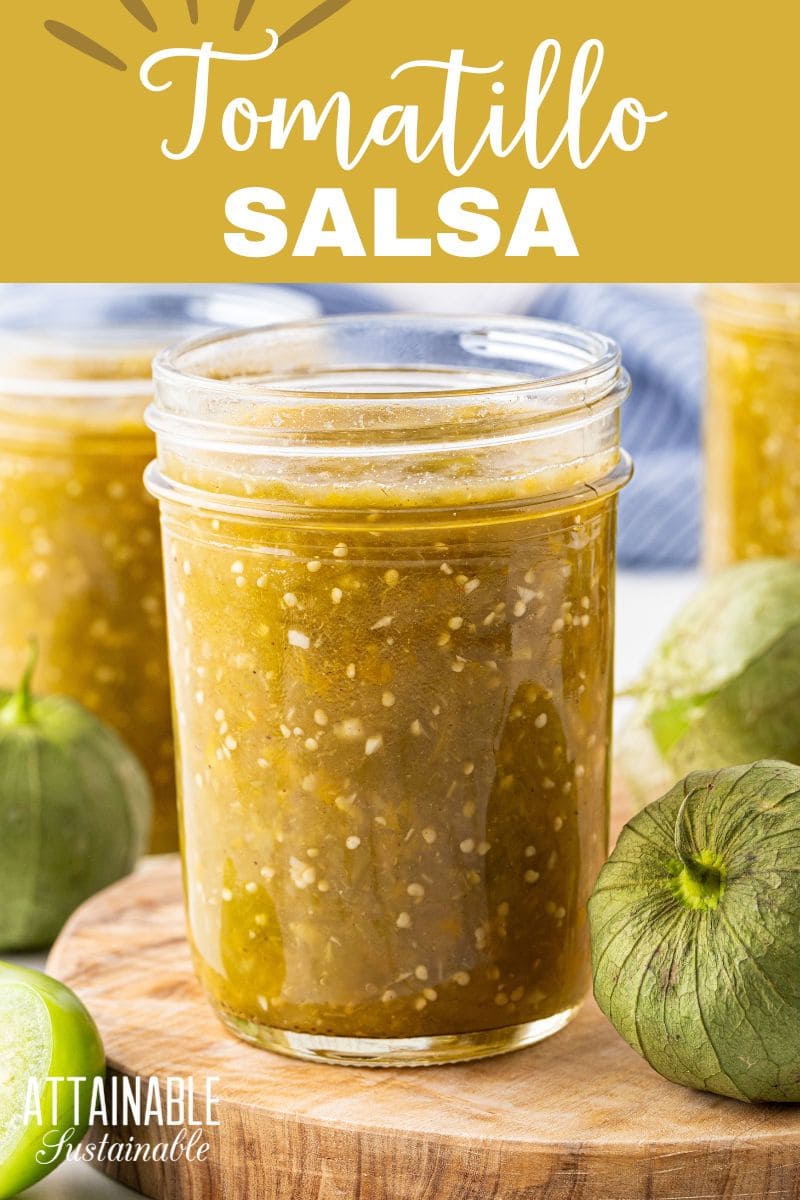Tomatoes are the usual star of the show in salsa recipes, but lesser-known tomatillos offer a different flavor. You may have tried salsa verde (green salsa) at your favorite Mexican restaurant or from a jar, but why not try canning tomatillo salsa at home?
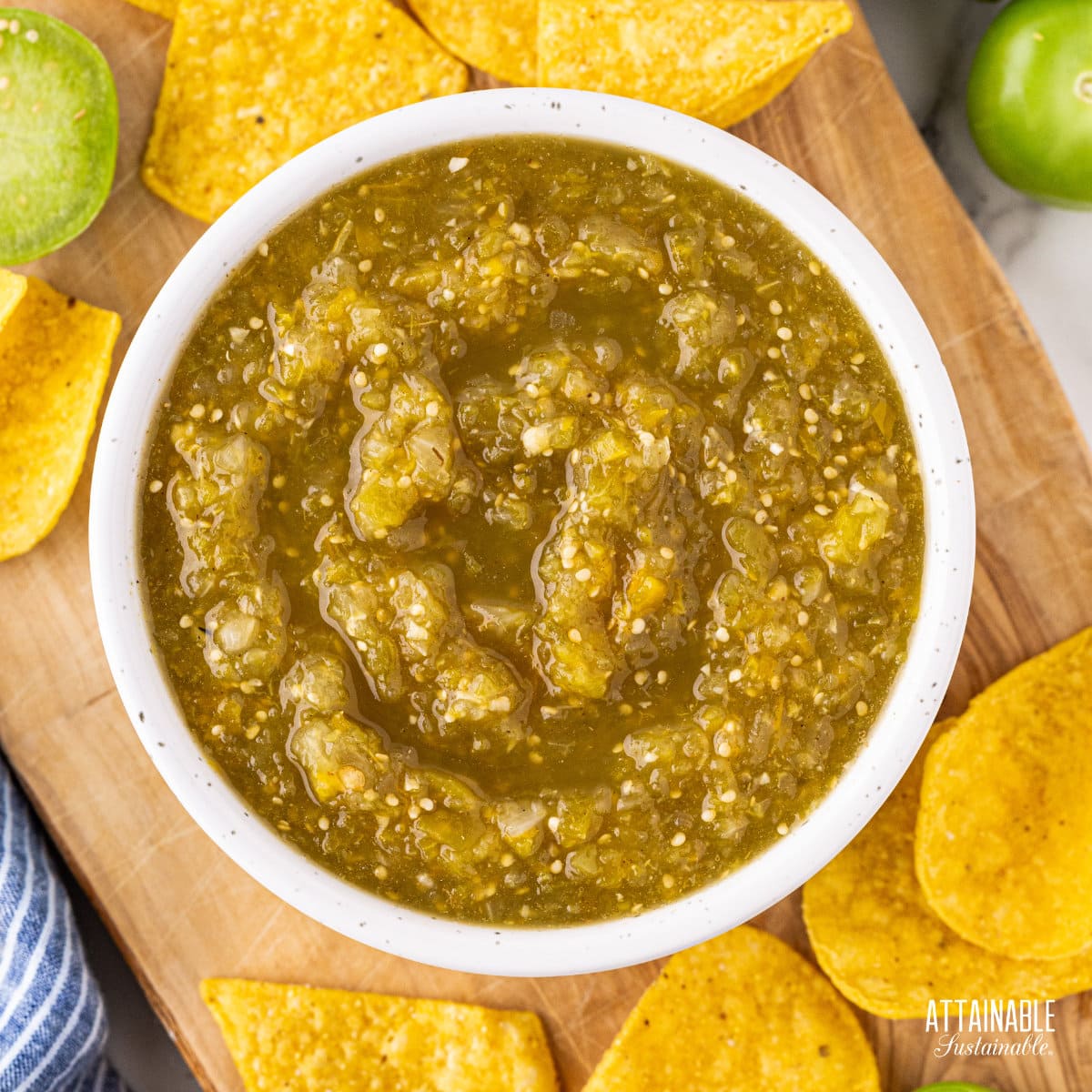
In my climate, I struggle to grow enough tomatoes to fill the pantry with salsa. Growing tomatillos is much easier for me.
Roasted Tomatillo Salsa
With an abundance of these green fruits on hand, it makes sense to turn them into a green salsa for the pantry. I make no claim that this is an authentic salsa verde recipe, but it’s one that is safe for canning and features a tangy flavor that will be much appreciated in the pantry.
This salsa verde canning recipe calls for roasting the vegetables to add a slightly smoky flavor; if you’d prefer to skip this step, it is safe to do so.
Not ready to dive into canning yet? Give this fresh tomatillo salsa recipe a try or simply make this recipe and refrigerate for immediate use.
5 Easy Steps to Transform Your Pantry!
Ready to switch from store bought to homemade? Let me help you make some changes! Grab my FREE five-part guide to getting started.
Ingredients
Tomatillos – Also called Mexican husk tomatoes, these fruits grow inside a papery husk. This husk is removed prior to using the tomatillos, which have a somewhat tangy flavor.
Onions & Garlic – You can use yellow, white, or red onions for this recipe, depending on what you like and what’s readily available. Garlic? If you’re not a fan you can leave it out, but is there anyone who doesn’t like fresh garlic?
Peppers – Using a combination of peppers provides a nice balance of heat and flavor in this salsa. I use jalapeno peppers for heat, but if you’re growing a different variety of hot pepper, by all means, use that. Adding a mild chile like banana peppers or green peppers to the mix adds flavor without increasing the heat too much. It is safe to vary pepper varieties in canning recipes as long as you do not change the volume.
Lime Juice – Yes, you really do need to add it, as the acidity from the lime juice helps to make this recipe safe for water bath canning. Use bottled lime juice to assure proper acidity; the pH of fresh lime juice can vary. If you prefer the flavor of lemon in your salsa, it is safe to use that instead. (Use bottled lemon juice.)
Spices and Seasonings – Add the salt in the measurements I suggest; if you find that you’d like the salsa a bit saltier, it’s safe to increase the amount. Cumin adds depth to the salsa, but if you’d prefer to leave it out, it is safe to do so.
Making the Salsa
Remove the husks from the tomatillos and give them a wash. Remove the ends of the onions and peppers. Halve the peppers and quarter the onions.
Roast the vegetables in the oven to give them a slightly smoky flavor.
Allow roasted veggies to cool, then pulse in a food processor to achieve a coarse consistency. If you don’t have a food processor, use a knife and aim for a quarter-inch dice on the tomatillos and onions and an even finer dice for the hot peppers.
Transfer the chopped veggies to a large stock pot and bring to a boil, then you’ll ladle the salsa into canning jars.
Prepare the Canning Pot
Fill a large canner with water. Just how much water to use depends on the size of jar you’ll be processing. You’ll want the water level to sit at least an inch above the full jars during processing.
Do this before you begin filling the jars, since it can take awhile for the water to boil. Turn the heat to high and set the lid on the pot; this helps heat the water faster.
Water Bath Canning Instructions
Wash the canning jars and check the rims for nicks that could interfere with sealing. You can use pint jars or half-pint jars for this recipe.
Transfer the hot salsa into jars using a canning funnel.
Use a damp cloth to wipe the rim of each jar; a little bit of food on the jar rim can prevent the lids from sealing properly. Set the lids in place and screw the bands on firmly tight (but not too tight). Use a jar lifter to transfer jars into the gently boiling water.
The water in the pot should cover the jars by about an inch or two. If necessary add more water to the canner.
Process jars for the recommended time. (See below.) When time is up, use the jar lifter to transfer jars to a flat surface that’s padded with a kitchen towel. Allow jars to cool completely. As they cool, you’ll begin to hear a canner’s favorite sound: That lovely little tink! that indicates a successful seal.
Once jars are thoroughly cooled, check the seal on all of the jars. The lid should be concave and solid. If it flexes at all, it’s not sealed. (Place any jars that didn’t seal in the refrigerator and use them first. They are not shelf stable.)
Remove bands from cooled jars and rinse the jars. Store jars without the bands.
Serve this tomatillo salsa verde with chips, as a topping for tacos, or add it to your homemade chili.
Be sure to try my tomato salsa for canning, too!

Tomatillo Salsa
Ingredients
- 3 pounds fresh tomatillos
- 3 6" long banana peppers
- 1 jalapeno pepper
- 1 large onion
- 5 cloves garlic
- ¼ cup lime juice bottled
- ¼ cups apple cider vinegar
- 2 teaspoons non-iodized salt
- 1 tablespoon cumin
Instructions
Prepare for Canning
- Wash the jars you'll use in hot soapy water, making sure each is clean and free of nicks in the rim, which could impede sealing.
- Place empty jars in a canning pot with enough water to cover by an inch or two, cover pot, and set on high heat. It can take awhile for the water to heat, so get it started before you begin making the recipe.
- Wash canning lids and rings in hot water; set aside.
Making the Salsa
- Remove the husks and stems from the tomatillos; wash and dry.3 pounds fresh tomatillos
- Cut tomatillos in halves and place cut side up on a baking tray. Broil for 5-10 minutes, just until the tomatillos begin to show a little browning.
- Meanwhile, quarter the onion, halve the peppers, and peel the garlic.3 6" long banana peppers, 1 jalapeno pepper, 1 large onion, 5 cloves garlic
- When the tomatillos are properly roasted, transfer to the carafe of a blender.
- Put the remaining cut vegetables on the baking tray and broil as you did the tomatillos. Add cooked veggies to the blender carafe, breaking the onion up into layers.
- Process to achieve preferred texture. Leave it slightly chunky or make it a smooth puree.
- Transfer tomatillo mixture to a large saucepan and add remaining ingredients. Bring to a boil over medium-high heat, stirring frequently. Reduce heat and simmer for ten minutes, stirring frequently.1/4 cup lime juice, 1/4 cups apple cider vinegar, 2 teaspoons non-iodized salt, 1 tablespoon cumin
Canning the salsa:
- Ladle hot salsa into pint or half-pint jars, leaving 1/2" head space. A canning funnel makes this easy.
- Wipe jar rims to remove any salsa that may have spilled. A clean rim is essential to a good seal.
- Set jar lids in place. Screw bands on finger tight, firmly, but don't crank the rings on.
- Use a jar lifter to gently submerge jars into boiling water canner. Water should cover the top of the jars by an inch or two. The water will cool somewhat in reaction to the addition of the jars. Return the water to a low boil and set the timer.
- Process for 15 minutes, 0-1,000 feet altitude; 20 minutes, 1,001-3,000 feet altitude; 25 minutes, 3,001-6,000 feet altitude, 30 minutes over 6,000 feet.
- Allow jars to cool overnight.
- Check for seal: the lids should feel solid and slightly indented. If they flex, they are not shelf stable and should be refrigerated and used first.
- Wash jars, remove rings, and store in a cool, dry place for up to a year.
